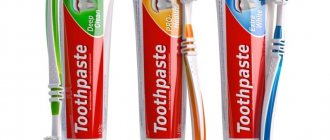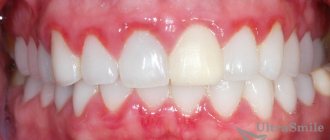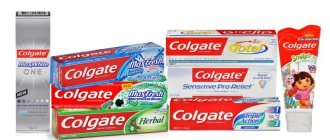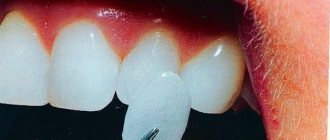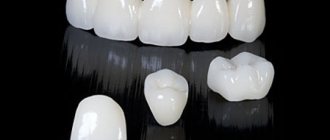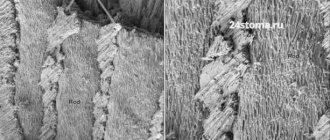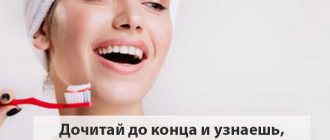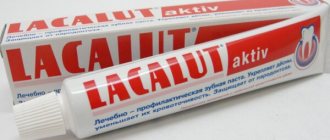Regular and complete oral hygiene is the key to healthy teeth, gums and other structures in this area. Of course, hygiene in this case is based on brushing your teeth, the correct implementation of which today is impossible without the use of toothpaste.
However, the market for oral hygiene products today is crowded. The shelves of stores and pharmacies are full of toothpastes, and the number of their manufacturers is amazing.
In such realities, the question arises - “how to find the best toothpaste that suits me?” To get the answer, you need to have a clear understanding of the classification, as well as the principles for choosing this product for oral hygiene.
What types of toothpastes are there - classification
The ability to choose is an important skill, on which the condition of the structures and health of the oral cavity subsequently depends. An incorrectly selected oral hygiene product can provoke the development of a number of serious problems such as increased tooth sensitivity and bleeding gums.
You may have to visit a dentist before purchasing. The doctor will examine the oral cavity, point out nuances that require adjustments, protect you from making the wrong choice, and tell you what toothpaste you need.
When purchasing, it is important to remember the classification, within which toothpaste is divided into the following types:
- Children's - these do not contain aggressive components, they are known for their gentle effect on the structures of the oral cavity. It is important to pay attention to the age limit indicated on the packaging. When buying children's toothpaste, also make sure that it contains dicalcium phosphate and silicon dioxide, and that the CDV value does not exceed 50 units. It is also important to remember that it is not advisable for an adult to brush their teeth with children’s toothpaste; it is intended primarily for young children and adolescents.
- Whitening - the peculiarity is that this paste contains microparticles of abrasive materials used in dentistry. Thanks to this composition, the whitening helps get rid of stubborn plaque (but does not get rid of tartar). At the same time, tooth whitening paste is not recommended for people with thin enamel or hypersensitive teeth, the problems will worsen.
- Anti-caries - the peculiarities of the chemical composition of this type of hygiene products allow them to penetrate into hard-to-reach places. The components that are included in anti-carious toothpaste help strengthen the enamel layer and reduce tooth sensitivity. This type of toothpaste is used in the initial stages of carious formations; it strengthens the enamel, preventing the spread of caries.
- If there is bleeding, sensitive gums need care. Pastes of this type contain special components (often of natural origin) that have anti-inflammatory, hemostatic and antibacterial effects, and also accelerate tissue regeneration. When using a correctly selected paste of this type, after 20-30 days, inflammation of the gums is eliminated, they stop bleeding, and other problems can be dealt with.
- Hygienic (preventive) - if the previous options had features, then hygienic toothpaste can be called standard. This choice should be made by people with a completely healthy oral cavity, in the absence of complaints of increased tooth sensitivity or thinning of the enamel layer. They have a slight whitening effect, have an antibacterial effect, strengthen enamel and maintain gum health, preventing caries and periodontal disease.
Causes of cervical caries
- Insufficient mineralization of enamel.
Considering the fact that in the cervical region it is thinner by definition, this factor is one of the determining ones. - Poor hygiene.
Plaque and tartar are most often localized on the inside of the teeth in the area of contact with the gum. - Vitamin deficiency and gum disease.
In both the first and second cases, deep gum pockets are formed in which food debris accumulates, which is why there is a high concentration of pathogenic bacteria. - Heredity.
If one of the parents suffered from cervical or circular caries, then there is a high probability that the child will also develop this disease.
Otherwise, the causes of cervical caries are the same as classical ones. Diet has a great influence: foods high in carbohydrates have a negative impact on dental health, regardless of the quality of hygiene and hereditary predisposition.
Many people confuse cervical caries and wedge-shaped defect. However, these two diseases have completely different natures and are similar only in the affected area.
Disadvantages of toothpastes
It was invented to take care of the condition of the structures of the oral cavity and maintain human health. If we exclude second-rate products from unknown manufacturers and talk about good brands, the negative impact of using the paste for a healthy person is minimal (provided it is chosen correctly).
But toothpaste has relative disadvantages:
- Impact on the gastrointestinal tract - some substances contained in toothpaste, penetrating into the gastrointestinal tract, can contribute to the development of dysbiosis or episodic outbreaks of diarrhea. But for brushing your teeth to lead to such results, a person must have serious problems with the condition of the gastrointestinal tract or he must brush his teeth more than 2-3 times a day.
- Some aggressive components penetrate the systemic bloodstream, being absorbed through soft tissues during tooth brushing. However, manufacturers have tried to minimize this risk by adding menthol to the paste, which cools the mucous membrane, reducing the intensity of absorption.
- Restriction in use - refers to those toothpastes that are intended for treatment and have, for example, a whitening effect. This can be used for periods of 2-4 weeks, taking breaks; constant brushing of teeth with such means can be harmful.
- Addictive effect - dentists are convinced that if you brush your teeth with the same toothpaste for 2-3 years or more, its effect decreases. To prevent this, you should choose 2-3 pastes for yourself and change them periodically.
- Colors and flavors – today you can often find red or orange strawberry or peach toothpaste on store shelves (colors and flavors may vary). Even if natural food colorings and flavorings are used, they can cause an allergic reaction. Therefore, it is safer to give preference to classic pastes. The classic option is white.
Treatment procedure
The treatment plan is determined by the stage of the lesion:
- if there is only a white spot on the enamel, removing plaque and remineralization is enough. Additionally, periodontal cleaning can be performed;
- if a dark spot has already formed, grinding is performed, the affected tissue is removed, restoration or remotherapy is performed;
- when a cavity is formed, it is processed, the affected tissue is removed, and a filling is performed;
- with a large cavity depth and inflammation, removal of the affected pulp, root canal treatment, and filling may be required.
Treatment of deep cervical caries is complicated by the location of the affected area: blood and saliva enter the treatment area. At the white spot stage, it can be removed without anesthesia. If the enamel has already darkened or begun to deteriorate, the doctor performs anesthesia before starting treatment.
How to choose the right toothpaste
When choosing good toothpastes, it is important to find a product that best suits you according to other criteria. To do this, it is necessary to take into account a number of nuances:
- Purpose – for what purpose are you buying the paste, what task should it perform? Perhaps you have problems with the condition of your oral cavity that require correction.
- Composition – for a particular person, the best paste is made by the components it contains. By paying attention to the composition, you can identify the key components for yourself that must be present or absent in the required paste.
To make it easier for you to choose the best whitening toothpastes for yourself, let’s look at the mentioned nuances in more detail.
Features of treatment of cervical caries at home
It is impossible to cure cervical caries at home when the enamel is already damaged. Conservative treatment is possible at the stain stage, when the doctor prescribes enamel remineralization products and preventive hygiene products that can be used at home. Some experts advise using folk remedies, in particular, rinsing with infusions of sage, lemon balm or propolis. However, such measures are only useful for the prevention of cervical caries and in no case can cure the disease in an advanced state.
Criteria for prescribing toothpaste
- Inflamed or swollen gums, the presence of bleeding and discomfort are a clear sign that preference should be given to a therapeutic effect. Ideally, you should take a closer look at dental products that contain chamomile or oak bark extract.
- If the shade of the tooth enamel layer changes towards brown or yellow due to bad habits or addiction to drinking coffee, it is better to choose a toothpaste with a whitening effect; it will help clean and brighten the enamel.
- If the enamel is thinned or the teeth are highly sensitive to cold and hot, give preference to gentle pastes, usually these are marked o.
- If you notice even small patches of caries on your teeth, but you can’t go to the dentist now, purchase an anti-caries paste that will slow down the progression of the problem.
Why is cervical caries considered the most dangerous?
- The enamel in the neck of the tooth is the thinnest and most vulnerable, and the same can be said about dentin. Caries in the cervical region very quickly affects deep tissues.
- When teeth are affected by cervical caries, the patient detects the disease only when pain occurs.
- Treatment is complicated due to the proximity of the lesion to the gum line (especially molars). The most difficult case is considered to be cervical caries on a wisdom tooth.
- It is caries in the cervical area that most often causes complications and is the reason for tooth extraction.
Toothpaste composition criteria
- Containing fluoride is a good option, providing a pronounced antibacterial effect and preventing the occurrence of carious lesions. But fluoride negatively affects the condition of bone tissue, so the use of such a paste should be alternated with products that do not contain fluoride.
- Soda-containing sodium carbonate particles in dental products serve as an abrasive, which over time damages the enamel and mucous membranes of the mouth. If you need to whiten your teeth and clean them of plaque, this paste can be used, but it also needs to be alternated.
- Plant components – it’s good if the paste contains extracts of propolis, oak bark, chamomile, and pine needles. These components do not cause harm and constantly maintain the condition of soft tissues.
- The concentration of parabens is not higher than 2% - parabens are preservatives that extend the shelf life of dental products, but when their content exceeds 2%, a health hazard appears.
The most dangerous cervical dental caries
Cervical dental caries is caused by the activity of the bacteria Streptococcus mutans, so there is no need to talk about any fundamental differences from other types of caries. Visually, the lesion differs only in location and is observed, as a rule, among people over thirty years of age. However, cervical caries of primary teeth also occurs. In children, the disease often develops into circular caries, like a tooth encircling the neck. The disease should not be confused with enamel erosion and wedge-shaped defect.
Additional selection criteria
- Expiration dates are a less serious, but important nuance. Always check the manufacturing date and expiration date; you may not be poisoned by expired toothpaste, but its effectiveness will be reduced.
- RDA value - this value indicates the amount of abrasive materials in the paste. The higher this indicator, the more thoroughly it cleans the tooth surface, but also damages the enamel layer. If you are not buying a special whitening paste, make sure that this indicator does not exceed 100 for an adult toothpaste and 50 for a child’s toothpaste.
Symptoms
A stain on a tooth is a sign of caries
First, if you look closely at the tooth, you can see a small white spot on its frontal surface near the gum. But very often it is covered by gums or tartar, so only a dentist can notice it (this is why it is so important to undergo medical examinations twice a year). The tooth doesn't hurt.
After this, thin enamel and dentin are destroyed quite quickly with infection penetrating into the pulp (soft tissue penetrated by nerve endings and blood vessels). This is a complicated carious process. A person experiences pain when eating cold, hot, sour and sweet foods. The pain is severe and does not go away immediately after rinsing.
The next thing that appears is severe throbbing pain, sometimes accompanied by an increase in body temperature - a sign of periodontitis. If it is not treated promptly, the infection can spread to the soft tissues and bones of the jaw.
Comparative analysis of toothpastes
To decide which toothpaste is better to buy in a pharmacy or store, consider the rating of reputable brands that you can choose without fear:
- Aquafresh is a standard option in an affordable price category; you will find it on the shelves of any supermarket. It has no pronounced shortcomings, but also cannot boast of variability.
- Lacalut is another affordable and widespread option; it is preferred when it is necessary to whiten enamel, but you should use them continuously for no longer than 4 weeks.
- Parodontax is a good combined option containing components against bleeding gums, as well as fluoride and soda particles, the price category is average. It is not recommended to use this for a long time without breaks.
- Sensodyne - this representative of the rating is intended for use for medicinal purposes for inflammation of the gums. The effect of use occurs already in the first week, but you cannot use it for a long time.
- ROCS is a popular, but not budget line, in which there is a separate distinction between children's and adult toothpastes. The line includes different types, each of which is designed to solve specific problems.
- Splat is a competitor to the previous one, as they are presented in similar price categories, and also have different product options aimed at eliminating specific problems. In the Splat series you will also find children's toothpaste for different ages.
- Forest balm is an inexpensive but bright representative; these toothpastes contain plant extracts and extracts. A good option for long-term use if you want to improve the condition of your gums.
Author: Zhukov M.A.
What to look for when choosing?
Remember that comprehensive dental treatment will eliminate all problems in the oral cavity. The main thing is to contact an experienced doctor who uses the latest equipment and uses modern technologies. The choice of hygiene product is no less important. The drug must not contain harmful ingredients. You should choose a product carefully, taking into account its composition. It's difficult to navigate through the huge assortment. The variety of brands and types confuses the buyer. To avoid harming yourself, you need to consult a dentist.
After all, the patient may not be suitable for high abrasive properties or the presence of fluoride. Therefore, the appropriate remedy will be different for everyone, depending on the pathological situation and the characteristics of the body. The general selection rules are:
- The remedy should facilitate therapy and prevent the recurrence of the disease.
- Calcium compounds and fluorides strengthen the enamel. They are recommended for mineral deficiencies to eliminate the vulnerability of crowns.
- To prevent the proliferation of pathogenic microbes in the oral cavity, antiseptics such as chlorhexidine, as well as the enzymes lysozyme and lactoperoxidase, are included in the preparations.
- A special natural protein that contains iron is lactoferrin.
- Products with hydrogen census and papain help remove soft plaque, which inhibits the formation of stones.
Moderate abrasiveness does not allow the crowns to be overloaded. Such resources contain potassium ions. This reduces the vulnerability of nerve fibers in dentin. Strontium chloride and sodium fluoride help reduce the lumen of the tubules, which protects the sensory nerves. Brands of gels and pastes with herbal ingredients are prescribed for damaged and sore gums. Soft tissue therapy allows you to fully clean the entire surface of the crown, capturing the cervical area, where pathogenic bacteria most often accumulate.
How often should you visit the dentist?
In 2013, scientists analyzed[] data from medical examinations of 36,000 children. With regular preventive examinations, the likelihood of subsequent requests for treatment was indeed lower. But preventive examinations are economically justified no more than once a year.
Further research showed[] that it was not preventive examinations as such that had a positive effect, but the use of dental sealants. Dental sealants are coatings that are applied to the chewing surfaces of teeth to protect them. This procedure is most effective for children when the teeth are not yet damaged.
But sealants, when applied correctly, last from three to five years. Therefore, in this case, you can get by with fewer visits to the dentist.
